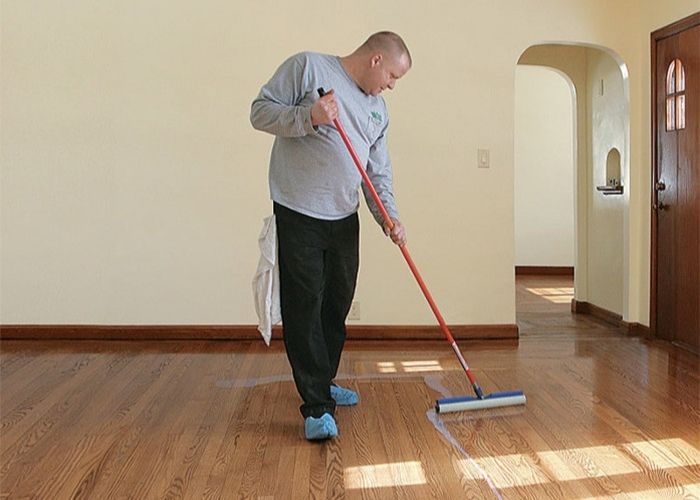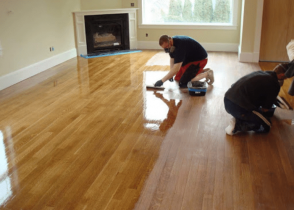For all the things we love about polyurethane, the wait time isn’t one of them. So it is natural to want to know how long to wait between coats of polyurethane on hardwood floors so you can plan your time better.
Is it long enough for you to go pick your kids up from school, head to the gym, or plan your wedding?
Fortunately, the wait times have improved significantly over the years. So, depending on the product you use, you might be in for a pleasant surprise.
How Long Should you Wait Before Applying the Next Coat of Polyurethane on Hardwood Floors?
If you use water-based polyurethane, you only have to wait between 2 to 4 hours before applying the next coat. However, when using oil-based polyurethane, you might wait for 10 to 24 hours. You can apply the next coat in as little as 4 hours if you are using fast-drying, oil-based polyurethane.
How Many Coats of Polyurethane Should I Apply on Hardwood Floors?
So, how many layers of polyurethane to add?
You should apply at least three coats of polyurethane on hardwood floors. Of course, this will depend on the type of polyurethane you are using.
Oil-based polyurethane will rarely need more than three coats on floors. Hardwood floors are high traffic areas, so you need a nice, thick layer to protect the wood for years.
On the other hand, when applying water-based polyurethane to wood floors, you might need to apply four or five coats. This is because water-based polyurethane tends to raise the grain of the wood, which is one reason why you may have to apply several more coats before you get a smooth finish.
Read also: What to do when polyurethane does not dry.
Do I have to Sand Between Coats of Polyurethane on a Hardwood Floor?
You should always sand between coats when applying oil-based polyurethane on hardwood floors.
However, you may not need to sand between coats when using water-based polyurethane, depending on the brand of product you buy. This is especially true if you want to avoid the risk of a cloudy polyurethane finish.
Sanding helps to get rid of bubbles, dust nibs, and lint. It also makes it easier for subsequent coats to stick.
While sanding does the same for water-based applications, it isn’t as necessary. As long as the surface remains clean and free from dust, you can tack it and apply the next coat without abrading the surface.
When you apply the next coat of polyurethane within ten hours, it will stick to the previous one just fine. I should mention that you can also do the same for oil-based polyurethane, but it’s better to play it safe.
Sanding between coats of polyurethane is the only way to properly get rid of dust and other impurities that show up. Yes, it takes more time, but it gives a higher quality finish at the end.
Related read: What happens if you don’t sand between coats of poly?
What is the Best Applicator for Polyurethane on Hardwood Floors?
The best tool for applying oil-based polyurethane on hardwood floors is a lambswool applicator. It has a reasonable absorption rate, doesn’t leave as much lint as the competitors, and gives a smooth finish.
However, you have to prepare the applicator properly by removing excess lint before using it. If you don’t, you’ll ruin the floor before you even begin.
When it comes to water-based polyurethane, the T-bar is the best applicator. Also called a snowplow, the T-bar does a great job of spreading the water-based polyurethane without absorbing too much of it.
It is very popular because it does not leave any lint or bubbles.
In place of a T-bar, you can also use a microfiber roller to apply water-based polyurethane. This is the best option when applying the finish on floors with complex designs, such as parquets.
How Long do I have to Wait for the Stain to Dry Before Applying Polyurethane?
This depends on the type of wood stain. Penetrative wood stains take about 48 hours to dry on the surface. Non-penetrative wood stains on hardwood floors take about two weeks to dry completely.
Latex stains are the slowest of the bunch. You should wait at least three weeks before applying polyurethane to this type of stain.
Check out our article on “How long does polyurethane take to dry” for more info on poly drying time.

Which Type of Polyurethane is Best for Hardwood Floors?
This will depend on the type and color of the hardwood floors:
- Water-based polyurethane can be used on any hardwood floor because it dries clear and does not change color over time, unlike oil-based polyurethane.
- Oil-based polyurethane has a yellowish or amber tint, which gets darker over time.
So, in general, people prefer to use oil-based polyurethane on dark floors.
However, the yellow tint can, in some cases, add more life to the wood. As a result, it is not uncommon to find people applying oil-based poly on light woods like maple.
If you are concerned that the wood looks too dull, you might want to use oil-based polyurethane. (Find out how to tint polyurethane in our guide.)
Another thing to consider when picking a polyurethane finish for hardwood for floors is the luster. The most common sheens are satin, semi-gloss, and high gloss. Many people like high gloss finish on their floors.
The problem with water-based high-gloss finish is that it shows scratches easily.
This may not be a problem in the first year or two, but the flaws will become more evident after that.
Due to its yellowish tint, oil-based polyurethane does not have the same issue with a high gloss finish. So use a clear coat that won’t yellow.
When will the Hardwood Floor be Ready for use After Applying Polyurethane?
You should typically wait at least 48 hours before you start bringing in furniture and walking on the floor after applying polyurethane. Then again, this also depends on the type of polyurethane you used.
Water-based polyurethane usually dries completely in two days, but oil-based polyurethane needs about two weeks.
After a couple of days, you can walk around with socks on a floor coated with oil-based polyurethane but try not to put any furniture on it for at least a week.
In some cases, oil-based polyurethane needs about thirty days to cure before use.
Interesting read: Can you spray urethane over lacquer primer?
Final thoughts
As you can see, how long you have to wait between coats of polyurethane on hardwood floors depends on the product you use.
It can take as little as 2 hours with water-based polyurethane or 24 hours with regular oil-based polyurethane.
Of course, the wait time will also depend on the product you use. To know more, check out our reviews of the best water-based polyurethane for hardwood floors and the best oil-based polyurethane for hardwood floors.


We refinished neglected floors in a foreclosed rental property. Went from questionable to great. Used high gloss for the first coat of poly. Should have known, but didn’t like the wet look. Put satin on over the the high gloss and it worked just fine. After five years it still looked great.
Hi David,
Great step to step guide of polishing hardwood floor. I am just wondering how long do you have to wait between coat for polyurethane sealer.
Thank you.
Thanks – Check out this blog post to get all your questions about sanding sealer vs poly answered.
Hi, your comments are very useful. My question is, when floor finishers say three coats of oil-based poly, does that mean, one coat of sealer and two coats of poly? Thanks.
Thanks for stopping by Doug. I’m not sure I got your questions right? But I’ll try to answer it anyway. Polyuurethane are sealers, so if it says 3 coats of oil-based poly – then it’s just that – 3 coats of sealer.
I have 7000 square feet of oak hardwood flooring. Some of it is from the 1830’s. Some of it from 2007.
It’s in the Crofoot Ballroom in Pontiac, Michigan, and we think its the oldest commercial building in Oakland County.
We do hundreds of rock and roll concerts there per year.
And we do fancy banquets — weddings and bar mitzvahs.
We end up mopping the floors five times a week with a mild all purpose cleaner and water.
When the rooms get “rockin” the floor joists in the basement move back and forth. That movement has got to be crackin the polyurathane, but I can not observe the cracks.
In 2007 we used the oil-based poly, Satin finish, that is the house brand at Home Depot. It’s called “Pro Finisher”. We would walk and rock on it within 48 hours of finishing it. We have re-done the floor twice since then, in 2015 and in 2020.
But in the summer of 2020, we were closed because of the Pandemic. We did three coats of a Sherwin Williams oil based product, Armorseal Rexthane. We put on 3 coats. Unfortunately it only came in High Gloss. But we used it anyway because the sales man was so positive that it was the strongest poly out there. It sat there un-walked on for a month. So it had the time to cure. And now is performing very well. The only draw back is that the gloss shows imperfections, and its just not as pretty as a satin finish
In 1980, we had used a poly product at Saint Andrews Hall, a 1912 ballroom in Detroit, with an oak floor that had not been treated well in 60 plus years. We used something that sounded like “Enron”. It was very volatile. We used tanks of air, and carbon filters in our masks. And still we stunk for a month afterwards. People walked around the block rather than walking by the open front doors.
Three questions:
i) what do you think is the best polyurathane product out there for us?
ii) can we put a vinyl acrylic floor sealer and finish on an oak floor with poly, just like we use on a vinyl tile floor in a retail store. I think it might be a lot easier to strip and replace an acrylic sealer and finish, that replace the polyurethane.
iii) is there something I can put on the Armorseal Rexthane to make it appear Satin — a poly product? or a satin acrylic sealer/finish?
thankyou,
Maybe bona for floors? Otherwise, with how much traffic it gets, it’ll look satin in no time.